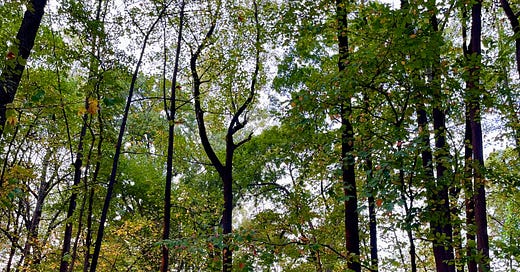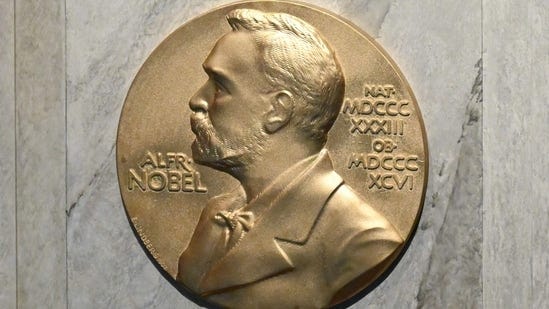Why nature is the best medicine you’re not taking
How green spaces help relieve pain, reduce stress, and boost your heart health. Plus, do Nobel Prizes still matter?
I'll happily tell everyone who will listen that green is my favorite color. I love walking in woods—the cool shadows, the quiet under the canopy. But did you know that nature offers more than just a break from the daily grind?
Recent research is revealing that green spaces can play a surprising role in how we process physical pain.
The urban woods near my home… I love coming here. :)
In Japan there’s something called shinrin-yoku, or forest bathing. It’s a practice where people immerse themselves in forests, using nature to soothe the body and mind.
While the physical act of walking has its own health benefits, there’s now scientific evidence that being surrounded by greenery offers something unique for both stress and chronic pain relief.
Research shows that spending time in forests can lower cortisol levels, the stress hormone, and reduce symptoms of anxiety and depression. Even a brief walk among trees can alter how your brain processes stress, offering a kind of mental "reset." The effects are almost immediate, with lasting benefits that stick around even after you leave the forest.
The impact on heart health is equally fascinating. A comprehensive review found that middle-aged and older adults who participated in forest walking programs saw significant drops in both systolic and diastolic blood pressure.
Beyond that, time spent in green spaces boosts heart rate variability—an indicator of a well-functioning cardiovascular system. It’s becoming clear that nature-based therapy can complement traditional treatments for cardiovascular health.
One of the more intriguing aspects of nature’s influence is its potential to ease chronic pain.
People suffering from conditions like migraines, fibromyalgia, or arthritis often report feeling better after spending time outdoors, particularly in green environments. The science is starting to explain why: exposure to green light may actually reduce pain sensitivity.
In a study published in Pain Medicine, researchers found that fibromyalgia patients who were exposed to green light for just an hour or more each day reported a significant reduction in pain intensity, frequency, and duration.
These patients, who hadn’t found relief through standard treatments, also experienced improved sleep and daily functioning—all without the side effects that often accompany pain medications.
But how does this work?
While scientists are still figuring out the exact mechanisms, we do know that green light stimulates the release of enkephalins which are natural painkillers in the spinal cord that act like opioids, but without the dangerous side effects. The color green also seems to reduce inflammation, which plays a key role in chronic pain.
Yet, the therapeutic power of nature doesn’t stop at just the color. Forests are rich in sensory stimulation—rustling leaves, the scent of damp soil, birdsong—which distracts the brain from focusing on pain. This multi-sensory engagement may help break the vicious cycle of chronic pain by pulling attention away from discomfort.
The benefits aren’t limited to deep forests or long hikes, either. Even short, regular exposure to urban green spaces can reduce stress and improve well-being. Whether it’s a walk in the park or sitting under a tree, spending time in green environments is a simple, accessible way to enhance both physical and mental health.
In The Distracted Mind: Ancient Brains in a High-Tech World, authors Adam Gazzaley and Larry D. Rosen suggest several practical strategies to help manage modern distractions.
Just 12 minutes of physical activity can enhance brain function and attention.
Every 20 minutes, take a 20-second break to focus on something 20 feet away to help restore brain function.
Spend at least part of your break in a natural setting or view pictures of nature, which can be restorative after only 10 minutes.
Engage in activities like doodling or mind wandering to activate the "default mode network," which is beneficial for creativity and attention restoration.
A 10-minute nap improves cognitive function; longer naps (30 minutes) can enhance reaction time.
Talking to others, either face-to-face or on the phone, helps reduce stress and can improve performance.
Reading or watching something funny can reduce stress and improve mood, as it lowers cortisol and increases dopamine.
Take a break to have a small snack and a drink to refresh yourself.
Reading fiction, especially in immersive formats, has been shown to trigger brain shifts that can be restorative.
Do the Nobel Prizes matter?
Back when X was still Twitter (before it became the mess it is today), there were vibrant, often fiery debates about the Nobel Prizes. One recurring argument was whether the Chemistry Nobel Prize had become more about biology than chemistry. Traditional chemists—physical, organic, inorganic—saw themselves as the gatekeepers, while others loved blurring those lines.
Fast forward to this year’s Nobel Prize announcements, and the debate is back. One-half of this year’s Chemistry Prize went to David Baker for developing computational tools to design proteins with new shapes and functions. It’s a monumental discovery since proteins are the machines that make life possible. The other half went to the innovators behind AlphaFold, which was released three years (a short time from discovery to prize).
But the questions always linger about two of the most revered prizes. What is physics? What is chemistry? And, does it even matter?
Well, yes and no. What you study often delineates your area of expertise. This was painfully obvious during the Covid-19 pandemic. Epidemiologists waded into virology and vice versa, often leading to wild extrapolations and incorrect conclusions. Public health experts extended their reach into areas outside their expertise such as economic policy (and vice versa), leaving the public confused and uncertain about who to trust.
As for the careers of the scientists themselves, discipline distinctions determine funding decisions, faculty positions, and public recognition. Researchers publish in scientific journals that align with their formal discipline and attend conferences where they rub shoulders with others in their field.
Which brings us back to the Nobel Prizes. They’re bending and twisting to stay relevant. The idea of backpropagation, crucial to modern AI, raises similar questions about the boundaries between disciplines.
Geoffrey Hinton, who won half of the Physics Nobel this year, didn’t win for backpropagation but for his earlier work on the Boltzmann machine. Hinton himself acknowledged that while the Boltzmann machine helped overcome an initial hurdle, once backpropagation was understood, it became the dominant method in AI, even though it doesn’t fit elegantly into Nobel categories.
But there was no way to award the AI-relevant method because it didn’t fit into the categories.
So, do the Nobel Prizes still matter? Absolutely. They bring recognition and legitimacy to breakthroughs. Hinton also notes that his Nobel will make people take his warnings about AI more seriously.
But as science progresses, we need to acknowledge that the boundaries between disciplines are fading. We face complex challenges like climate change, pandemics, and AI, areas that don’t fit neatly into physics, chemistry, or physiology or medicine - categories created by Alfred Nobel ages ago.
End notes…
I did a Hindi podcast interview.
It was my first time speaking in Hindi for a podcast recording, and since it’s neither my first nor second language, I appreciate your patience with any grammatical slips. However, the issue of antibiotic resistance and superbugs is so pressing in India that I felt compelled to step out of my comfort zone and share my thoughts.
A heartfelt thanks to Khyati P., Pranay Kotasthane, and Saurabh Chandra for inviting me on the Puliyabaazi podcast and giving me this opportunity!
If you’re interested in deep dives into policy, science, and technology, I also highly recommend subscribing to their Puliyabaazi newsletter. It’s full of thought-provoking content that provides a fresh perspective on some of India’s most critical issues.
That’s it for this week!






Nature can make you forget all your woes.
Oh, I love green spaces and get out everyday in our rainy climate for a walk. The oxygen, the effect on digestion, the overall feeling of wellbeing, mental calm, all make it totally worth it. In fact, a couple of weeks after my tumour removal two years ago, it snowed massively here. I went out in knee-deep snow and looked at the trees, ferns, mushrooms and the sun. I entered a kind of ecstatic state as if I had discovered the secret of life - nothing more than being alive and responsive...and this was inspite of the insane pain I was experiencing. I felt like I could die without regrets looking at that sight. If this sounds dramatic, honestly ask any cancer patient how incredibly happy they are to be alive.
So, I've a question related to cancer. But I can't post that info here. Any options that would not be a bother for you would be greatly appreciated. Thank you.